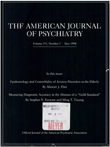Sylvian fissure size in schizophrenia measured with the magnetic resonance imaging rating protocol of the Consortium to Establish a Registry for Alzheimer's Disease
Abstract
OBJECTIVE: Since previous work indicated smaller than normal temporal lobe structures in schizophrenic patients, the authors tested the hypothesis that this abnormality might be reflected in abnormally large sylvian fissures. METHOD: The subjects were 48 schizophrenic patients and 51 normal comparison subjects matched groupwise with regard to age and sex. CSF spaces (sylvian fissures, temporal lobe sulci, temporal horns, third ventricle, lateral ventricles, and superficial cerebral sulci) were visually assessed with the magnetic resonance imaging rating protocol of the Consortium to Establish a Registry for Alzheimer's Disease (CERAD). RESULTS: The sylvian fissures of the schizophrenic patients were found to be bilaterally wider than those of the comparison subjects. There were no other significant differences. CONCLUSIONS: Schizophrenic patients appear to have larger than normal sylvian fissures, which may reflect smaller superior temporal gyri.
Access content
To read the fulltext, please use one of the options below to sign in or purchase access.- Personal login
- Institutional Login
- Sign in via OpenAthens
- Register for access
-
Please login/register if you wish to pair your device and check access availability.
Not a subscriber?
PsychiatryOnline subscription options offer access to the DSM-5 library, books, journals, CME, and patient resources. This all-in-one virtual library provides psychiatrists and mental health professionals with key resources for diagnosis, treatment, research, and professional development.
Need more help? PsychiatryOnline Customer Service may be reached by emailing [email protected] or by calling 800-368-5777 (in the U.S.) or 703-907-7322 (outside the U.S.).



